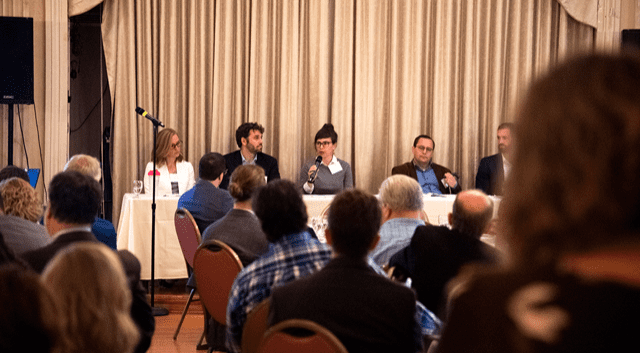Minneapolis aerial with Downtown Minneapolis skyline in the background and Loring Park with Loring Pond in the foreground, during early autumn.

Minnesota Accelerates Its Energy Transition with e–Lab’s Help
Minnesota is among the states leading the way in the transition to clean energy. Two of the state’s largest utilities have announced plans to achieve significant shares of carbon-free energy by 2030, and many other groups are working on similar innovative projects. Accordingly, the state’s energy community was well represented at e–Lab Accelerator in May 2019, with representatives participating in four of the 11 Accelerator teams.
At the e21 Forum in Minneapolis in August, with the help of the Great Plains Institute (GPI) and Center for Energy and Environment (CEE), co-conveners of Minnesota’s e21 Initiative, the four teams shared what they learned and how their projects are progressing. Acknowledging that Accelerator’s value can be realized only if teams share what they learned, GPI and CEE convened the half-day meeting so that the larger Minnesota energy community could hear from each Accelerator team.

Throughout the event, the Accelerator teams emphasized how the Minnesotan values of cooperation and conversation were helping to manage the challenges and opportunities of the state’s energy transition.
Introducing RMI and e–Lab Accelerator to Minnesotans
Rolf Nordstrom, GPI President and CEO, kicked off the event by explaining Rocky Mountain Institute’s approach and the Accelerator format and goals. An invitation-only four-day working meeting, e–Lab Accelerator brings together teams throughout North America that are working on high-impact and innovative projects at the forefront of the region’s electricity system. GPI had participated in previous e–Lab events and helped inspire some of the 2019 teams to participate. After Nordstrom’s introduction, each team described their projects to the group and answered questions. Below are summaries of those projects.
Great River Energy Comprehensive Planning
Jeff Haase, Zac Rucycki, and Justin Jahnz, from the Great River Energy (GRE) Demand-Side Resource Planning team, described the group’s work to improve the incorporation of demand-side efficiency and demand response in energy planning. The team’s aha moment came when they realized that planning was more efficient and effective when they could consider supply-side and demand-side resources together. GRE now intends to use modern planning tools that are dramatically different from the legacy tools unable to account for flexible demand.
Grid Modernization
Joseph Pereira and Chaz Teplin represented the GridMod Squad. At e–Lab, the team worked to formulate a vision for effective grid modernization and distribution planning that optimizes the deployment of distributed energy resources, enables grid decarbonization, and increases resilience. The team was able to create a draft Grid Modernization Playbook that contained (1) grid modernization priorities; (2) an idealized cooperative process for utilities, regulators, and stakeholders to follow; and (3) a checklist to guide the evaluation of grid modernization programs.
The team is currently working to turn their draft playbook into a report that regulators, stakeholders, and utilities can use to produce better and less contentious grid modernization plans. Attendees were curious about how the team’s work could be used in Minnesota’s regulatory environment, where Xcel has recently filed an integrated distribution plan.
Decarbonizing Minnesota’s Natural Gas End Uses
Audrey Partridge, Trevor Drake, Margaret Cherne-Hendrick, Luke Hollenkamp, and Nick Mark presented their challenging work to strategize how to decarbonize Minnesota’s natural gas end uses. The team described how buildings and other end uses were on track to increase their emissions, even while the electricity sector is decarbonizing (or at least taking the first steps along that path). Further, Minnesota is currently investing $0.1 billion to $0.2 billion each year into its existing $2 billion gas infrastructure to maintain necessary safety and reliability.
Costs were identified as a large barrier to decarbonization. In Minnesota’s colder climate, natural gas is less expensive than electrified options for space heating. Given this challenge, and the particularly important but contentious role of existing natural gas companies in the transition, the team found that simply starting this conversation and helping everyone understand the realities of the current system constituted significant progress. Going forward, the team expects to continue their work with a larger stakeholder group in Minnesota.
During the question-and-answer session, the Decarbonizing Minnesota’s Natural Gas End Uses team elicited the sole break from the “Minnesota nice” that was otherwise characteristic of the morning. When an audience member asked how the “difficult and unsexy” work of building efficiency and insulation could be prioritized, a team member noted, “I clearly and categorically reject the idea that insulation and efficiency are in any way unsexy!”

Taking Advantage of Battery Storage at Cooperative Utilities
Greg Ridderbusch, Ellen Anderson, Michael Noble, and Brian Burandt shared their work developing a battery storage game plan for cooperative electric utilities aiming to assess use cases for energy storage technologies. The team described how near-term storage opportunities, although not necessarily simple, were like “picking a $20 bill off of the street”—the opportunity was there, but it seemed too good to be true. They worked to understand how they could best develop the right customer programs and use storage to reduce demand charges and save customers money.
Minnesota Nice Ushers in Change
The e21 Forum highlighted both the progress Minnesota is making and the impact of e–Lab Accelerator. Thanks in part to this event and the hard work of the e–Lab teams, Minnesota is taking large strides as a leader in diverse sectors of the energy transition.

